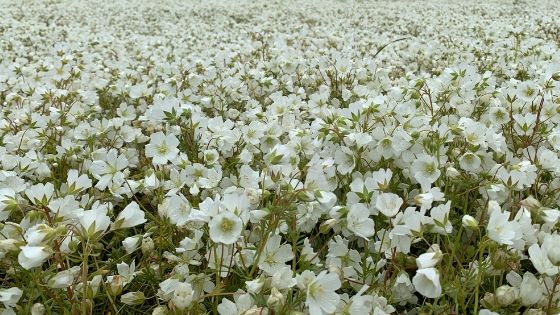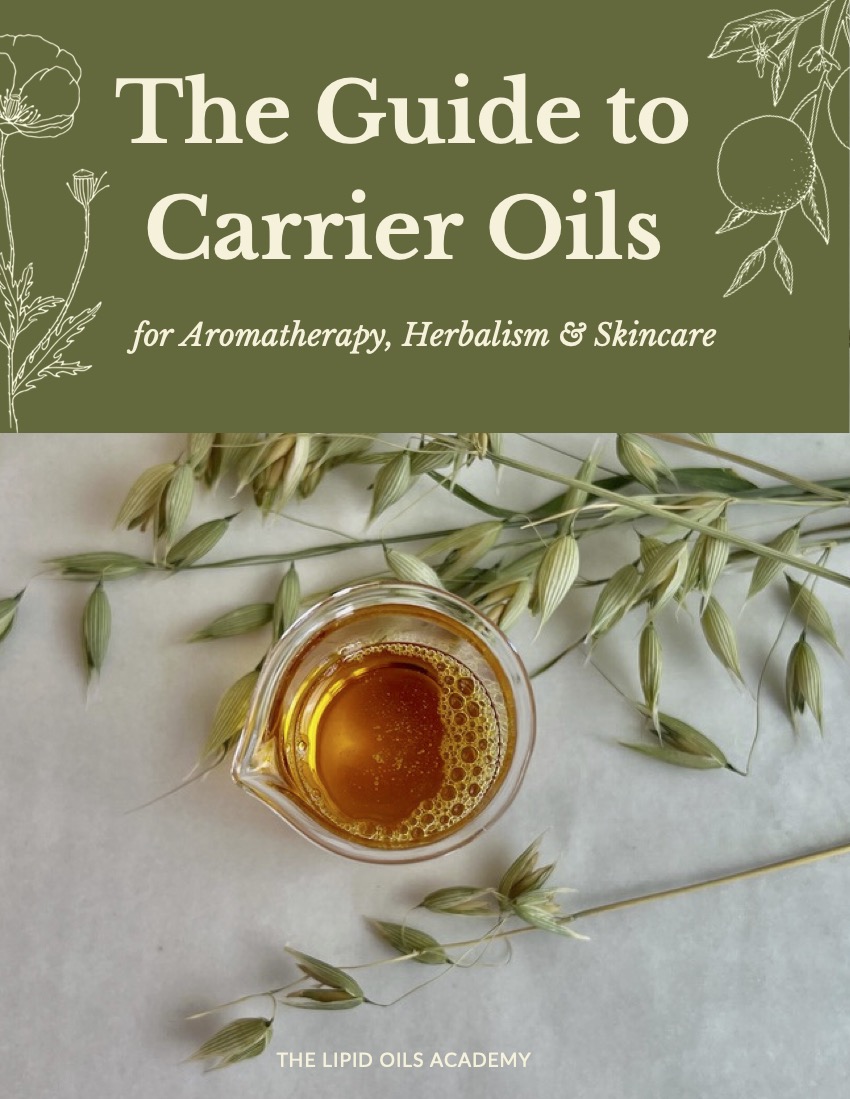Meadowfoam is a truly special oil, with its majority of twenty carbon monounsaturated fatty acid chains. These very-long carbon chains endow the oil with an unusual stability against oxidation that gives it a long shelf life as well as helping protect more sensitive oils when combined in a formula.
The oil feels soft on the skin and absorbs easily protecting and helping maintain moisture in the cells.
Limnanthes Alba (Meadowfoam) Seed Oil, a beautiful plant and oil and one that has many uses in skincare.
So why is it so hard to find organic meadowfoam seed oil?
With this question and others in mind, I headed to the meadowfoam fields in late May to meet with Jim Daniels of Natural Plant Products and see the fields in bloom.

I asked Jim the status of organic certification for meadowfoam seed as we stood at the edge of the field listening to the bees busily pollinating the flowers.
The short answer is that meadowfoam is not sold with organic certification for a variety of reasons.
Growing Meadowfoam Seed Oil
It is the nature of the crop, that meadowfoam crops move around the valley each year planted in different locations.
This practice ensures good soil and crop rotation practices are followed. Oregon Meadowfoam Growers (OMG), is a cooperative of multi-generational farms that employs a staff agronomist to advise each year’s crop and growing practices.
Once harvested Natural Plant Products purchases the seeds from OMG and presses the oil for markets across the globe.
Click the link here to visit Natural Plant Products website meadowfoam.com)
The movable nature of the fields where meadowfoam flowers produce seeds each season make organic certification nearly impossible. But the growing practices used by the farmer’s co-op are sustainable and ecologically sound.
Seeds are spread across the fields in the fall. They are not tilled and don’t require fertilizing. Over the damp winter they lay dormant and when the spring rains arrive they bloom in profusion.
With the damp Pacific Northwest climate, especially in winter and early spring, the meadowfoam seeds require no irrigation.
Minimal Intervention
One early spraying, well before the bees are in the fields limit pest damage of the plants. The farming practices of growing this crop are respectful of the earth and the environment.
Then once the seeds are collected they are processed into oil using three methods for use in cosmetics worldwide.

3 Methods Of Extraction
Solvent extraction is the least expensive type of the oil as this method captures the most oil from the seeds.
Expeller pressed meadowfoam seed oil is less costly in line with the volume of oil produced and considered more natural than the solvent extraction.
Recently in the last few years, Natural Plant Products has undertaken to produce a cold processed oil that is the most costly but the closest to a pure product.

The oil is extracted and refined according to Ecocert and COSMOS standards enabling the oil to join certified organic raw materials in certified products.
All this careful growing, handling and processing of meadowfoam seeds enables meadowfoam oil to be among the best cosmetic ingredients available to formulate with.
Are you working with meadowfoam seed oil in your formulas and recipes? Leave a comment below and share your experience.



I am a small hobbyist and have been making soap and lotion products for twelve years. Not a business but on occasion to special friends, I have sold a few. I like the smallness of my hobby. It has been a long time since I have used meadowfoam seed oil, because it was getting difficult to buy and I want a safe product, sustainably sourced, no chemical extraction. At 76 years old, I use a lot of my own soap and especially lotion to keep my skin up. I love the craft and the individuality one can put into it. I live in Florida, where there is a lot of sundamaged skin on many people, and my husband particularly at 80.
I get a lot of compliments on my skin for my age, so I must be on the right track.😉😊😊😊😊
Thanks Susan. I’m moving to Oregon. Not really, but it looks so beautiful there. Thanks you so much for everything you are helping to ensure all of your efforts for making natural cosmetics don’t go unseen. You are the best. Blanca
Thanks loads for solving the mystery. I love the oil and had a source many years ago who discontinued it, and I’ve wondered about the organic issue, and where I can find a trusted source. Your info was so interesting and valuable. Thanks much.
Hi Diane, Glad I could help. The organic question was the first question I asked when we visited the fields with Jim Daniels of Natural Plant Products in Oregon. They distribute the oil to a number of cosmetic supply sources, they don’t sell it retail. I buy mine usually from Lotion Crafter in Washington state. They have both expeller-pressed and cold-processed versions. In the old days, only solvent extracted was available so perhaps there might be organic in the future if there is enough demand.
How would I get quality Meadowfoam??
who would be a good company to deal with?
Really nice post, Susan. Thank you for sharing Natural Plant Products’ story.
Why sprayed at all? The blog post diminishes the fact that the fields are sprayed. I think it only fair to say why and with what.
wow huge field… smell good outside ha
that kind of good for skin …. good to know thank you for sharing
It is also grown in Canada. Organic
Hi Maureen, good to know.
Maureen, can you give us the source for purchasing organically grown meadow foam from Canada? Would really appreciate it!
Maureen, where can I buy organic meadow foam in Canada?
Can you share where meadowfoam is grown in Canada as I live in B.C. and would prefer to order from a Canadian grower.
Thanks
Hi Maureen, can you share a supplier for organic meadow foam in Canada
Sprayed with what??
Eileen you’d have to contact Natural Plant Products for that information.